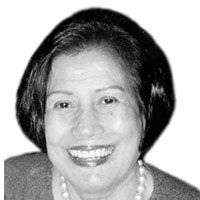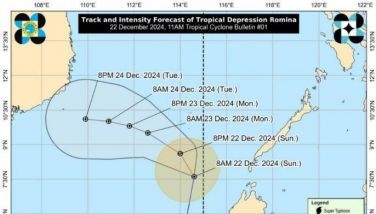Women of Mindanao

December 2, 2003 | 12:00am
Many of the women of Minda-nao are victims of poverty and conflict. But they also hold the key to peace and development in Min-danao.
That summarizes the report presented by the Mindanao Commission on Women, before the House of Representatives recently. Irene M. Santiago, commission chair, introduced the report by saying that there are three Mindanaos: the fast developing and urbanizing cities like Davao and Cagayan de Oro; the five at the bottom of the ranking among the 77 provinces in the country, namely, provinces of Sulu, Tawi-Tawi, Maguindanao, Lanao del Sur and Basilan, and the third, that of the women on whom families depend for survival and who are rarely recognized for their responsibilities and contributions.
Women make up half (49.9 percent) of the total population of 18 million in Mindanao (which is 24 percent of the country’s 76 million population).
But of the women in Mindanao, said Hadja Moklin Maina, former Department of Social Welfare and Development secretary of the Autonomous Region of Muslim Mindanao (ARMM), cultural minority women suffer most. These are the Moro and Lumad women, who are the poorest and powerless of the lot. This has been the result of armed conflict and continuing neglect of the minority populations, compounded by gender inequality
The report said that as of 2000, poverty was deepest and most severe in ARMM, and some parts of Western and Central Mindanao, regions which have the largest proportion of Muslims and Lumads. Within Mindanao, the highest poverty incidence was in ARMM at 74 percent, followed by Region XII at 58 percent and Region IX at 53 percent.
The report showed that Mindanao had the highest high school drop-out rate , and its average functional literacy rate was 75 percent compared to the national average of 84 percent. The surprising thing is that the girls stayed in school longer, the reason being that since they have less pressure to earn a living and there are fewer jobs available for them, they stay longer in school. In addition, cultural bias shows in the Moro and Lumad parents‚ becoming increasingly suspicious of the perspectives and values imbibed by their children.
The picture is dismal with the area’s having the highest infant and child mortality; highest maternal mortality rates, and inadequate knowledge of reproductive health issues. The government appropriates very little to Mindanao’s health budget as compared to how much it gives Central Luzon.
As true in the rest of the country, violence against women in Mindanao remains unabated. The most common form of violence is physical assault, incest, illegal recruitment, and involuntary prostitution, and many women are victims of violence in situations of armed conflict and detention.
A happy note is that Mindanao has fewer Overseas Fi-lipino Workers. Even if there is poverty in the area, few of its women work abroad. ARMM, whose poverty incidence is 57 percent, had only between 0.76 percent to 1.2 per cent share of OFWs compared to Central Luzon, which had a poverty incidence of 30.8 percent in 2000, but the highest percentage share of OFWs.
More dismal pictures: men get higher pay than women for the same amount of work. Less women beneficiaries are given land, and if they do, they get only about half of what is given to men.
Of the situation of women in armed conflict, the report said that upon their return to their bombed-out areas particularly after the Estrada’s all-out war policy, the women, in the absence of their husbands, took on the "complex responsibility of re-building a community ripped apart by war."
A bright note: The report said, "Historically, women have played important roles in peace-negotiation efforts. The Bangsamoro women regard themselves as ‘cleaners of the dirt of the community’ playing the role of mediators in conflict situations." For instance it cited the Arumanen women as having successfully involved in the negotiation process and were able to prevent conflict from escalating.
E-mail: [email protected]
That summarizes the report presented by the Mindanao Commission on Women, before the House of Representatives recently. Irene M. Santiago, commission chair, introduced the report by saying that there are three Mindanaos: the fast developing and urbanizing cities like Davao and Cagayan de Oro; the five at the bottom of the ranking among the 77 provinces in the country, namely, provinces of Sulu, Tawi-Tawi, Maguindanao, Lanao del Sur and Basilan, and the third, that of the women on whom families depend for survival and who are rarely recognized for their responsibilities and contributions.
Women make up half (49.9 percent) of the total population of 18 million in Mindanao (which is 24 percent of the country’s 76 million population).
But of the women in Mindanao, said Hadja Moklin Maina, former Department of Social Welfare and Development secretary of the Autonomous Region of Muslim Mindanao (ARMM), cultural minority women suffer most. These are the Moro and Lumad women, who are the poorest and powerless of the lot. This has been the result of armed conflict and continuing neglect of the minority populations, compounded by gender inequality
The report said that as of 2000, poverty was deepest and most severe in ARMM, and some parts of Western and Central Mindanao, regions which have the largest proportion of Muslims and Lumads. Within Mindanao, the highest poverty incidence was in ARMM at 74 percent, followed by Region XII at 58 percent and Region IX at 53 percent.
The report showed that Mindanao had the highest high school drop-out rate , and its average functional literacy rate was 75 percent compared to the national average of 84 percent. The surprising thing is that the girls stayed in school longer, the reason being that since they have less pressure to earn a living and there are fewer jobs available for them, they stay longer in school. In addition, cultural bias shows in the Moro and Lumad parents‚ becoming increasingly suspicious of the perspectives and values imbibed by their children.
The picture is dismal with the area’s having the highest infant and child mortality; highest maternal mortality rates, and inadequate knowledge of reproductive health issues. The government appropriates very little to Mindanao’s health budget as compared to how much it gives Central Luzon.
As true in the rest of the country, violence against women in Mindanao remains unabated. The most common form of violence is physical assault, incest, illegal recruitment, and involuntary prostitution, and many women are victims of violence in situations of armed conflict and detention.
A happy note is that Mindanao has fewer Overseas Fi-lipino Workers. Even if there is poverty in the area, few of its women work abroad. ARMM, whose poverty incidence is 57 percent, had only between 0.76 percent to 1.2 per cent share of OFWs compared to Central Luzon, which had a poverty incidence of 30.8 percent in 2000, but the highest percentage share of OFWs.
More dismal pictures: men get higher pay than women for the same amount of work. Less women beneficiaries are given land, and if they do, they get only about half of what is given to men.
Of the situation of women in armed conflict, the report said that upon their return to their bombed-out areas particularly after the Estrada’s all-out war policy, the women, in the absence of their husbands, took on the "complex responsibility of re-building a community ripped apart by war."
A bright note: The report said, "Historically, women have played important roles in peace-negotiation efforts. The Bangsamoro women regard themselves as ‘cleaners of the dirt of the community’ playing the role of mediators in conflict situations." For instance it cited the Arumanen women as having successfully involved in the negotiation process and were able to prevent conflict from escalating.
E-mail: [email protected]
BrandSpace Articles
<
>
- Latest
- Trending
Trending
Latest
Latest
Recommended

December 22, 2024 - 1:11pm



























